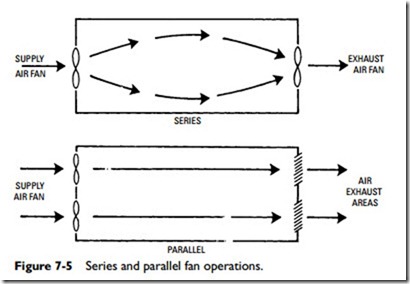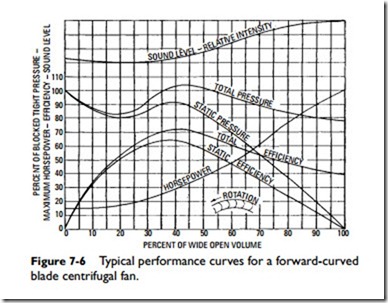Series and Parallel Fan Operation
Two separate and independent fans can be operated either in series or in parallel (see Figure 7-5). When two fans are operated in series, the cfm is not doubled. Instead, the total airflow is limited to the cfm capacity of one fan alone. Series operation is seldom desirable except when it is necessary to maintain the following conditions:
1. Constant pressure
2. Zero pressure
3. Constant vacuum
When fans are operated in parallel, they produce a total airflow equal to the sum of their individual cfm capacities. Parallel fan operation is necessary when a single fan is incapable of moving the total volume of air required or when airflow distribution is a factor.
Fan Performance Curves
Fan performance curves are provided by fan manufacturers to graphically illustrate the relationship of total pressure, static pressure, power input, mechanical efficiency, and static efficiency to actual volume for the desired range of volumes at constant speed and air density. A typical performance curve for a forward-curved blade centrifugal fan is shown in Figure 7-6.
General Ventilation
General ventilation involves the moving of a volume of air from one space to an entirely separate space, where concern for a con- centrated source of heat or contamination is not a factor. In this respect, it differs from local ventilation, which is used primarily to control atmospheric contamination or excessive heat at its source (see following section).
In general ventilation, the specific volume of air to be moved is measured in cubic feet per minute (cfm). The two principal meth- ods of determining the required cfm are as follows:
1. Air-change method
2. Heat removal method
Related posts:
Incoming search terms:
- parralel fans
- effect of multiple fans in series
- fan in series and parallel
- Ventilator manufacturers mail
- VENTILATION COOLING SYSTEM MANUFACTURERS mail
- mine fan series and parallel concept
- Air Ventilation Fan Manufacturers mail
- exhaust fan operation
- Ventilation Systems mail
- calculating fans in series
- series and parallel operation of mine fan
- CFM calculation of fans in series
- parallel ventilation
- parallel fan operation
- operation of fan in series in mechanical ventilation
- concerns about parallel fan operation
- fans in series cfm
- Duct Fan Manufacturers mail
- fan series and parallel in mine ventillation
- fan in series operation ventilation
- Fans - Exhaust mail

